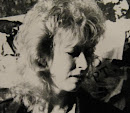My own view of Christianity is a synthesis of the classical civilisations of Europe with the life of Christ. It has little in common with the 'Old Testament'. It is Rome that gave us the great sacred depictions of the Holy Virgin, Queen or Heaven and her Divine Son. Christ is Dionysus, and indeed, himself says as much when he declares that he is the 'living vine'. Dionysus similarly WAS the Grapevine and the Grape, the Divine Sacrifice.
I love woodcarvings and for me, this particular depiction of Our Lady is a favourite as she embodies all that is most beautiful in the portrait of the Goddess, whether she be called Aphrodite, Venus or Mary. She wears a crown of roses and the Divine Child in her arms is clutching a cluster of grapes. How can this not be perceived as a thread that runs uncut from ancient pagan Rome to Christianity.
Some people denounce ancient traditions that were adopted by Christianity simply because they were followed by people who worshipped BEFORE Christ's birth. To me, this makes the tradition more genuine, more sacred, as it is Universal in nature.
Thus, I perceive Our Lady as the same Divine Mother who was worshipped by the ancients before the time of the birth of Christ, and Christ as the same Divine Child who was worshipped long before Jesus was born in the cave or stable in Bethlehem. I do believe that the name of that village, translated as 'House of Meat' originally denotes a place of very ancient sacrifice.
In any event, although I have many statues of the Holy Virgin and many carved from wood, most of them Italian, this is one of my very favourites for its ethereal quality and its ancient symbolism. I would like to do a little research as to the position of the Child in her arms actually. In most cases, he is held on the other hip, on her right side. In this instance, he is held on her left hip... is there a reason for this or does it simply follow another depiction, perhaps a painting?
In medieval times especially, symbolism was extremely detailed and every gesture, every accessory had significance in art. Being left-handed myself, I rather like the fact that the Christ Child is held on her left hip here, as I held my daughter Freya on the left side for the most part.
I believe all three of these woodcarvings were made by Anri, even though the labels were lost long ago. There are reasons why I love all of them, and they all are very different one from the other. On the far left is the Queen of Heaven. I love the regal beauty of this small statue, her delicate features and utter perfection.
On the far right is a portrait of Our Lady as a young mother, seated with her son. I am not certain why I love this position but I do and one of my favourite Goebel statues of Our Lady depicts her seated, holding a book as whe shows it to the infant Christ.
The statue in the centre, however, is my own ideal of motherhood and beauty I think, combining as it does all the gorgeous symbolism of the Goddess and Divine Mother, across all religions. I love the fact that her hair is loose, flowing down her back freely, that her chaplet is of roses and that she carries a cluster of grapes, symbol of the Bacchantes. I have collected a number of cameos that depict Bacchantes. To me, the Goddess and Virgin Mary are one and the same. Why would a real divine being be limited to one time and place, one incarnation???
Musings on every topic under the Sun
My Sites as Freyashawk
My Sites
Freya's Site
About Me

- Valkyrie Hawk
- My name is Eugenia-Maria Martino de Conde. Freyashawk is the name under which I write game guides and play many games. I specialise in Northern mythology but my original academic background is in History and British Law. Mine is the view of an exile, a Swan-Maiden rather than a god. Not an exile from heaven (that would be arrogant), but an exile nonetheless. I have lived in La Jolla, Nepal, London, Southampton, Manhattan, Roma, Pennsylvania et alia but spiritually belong to no land. Thus the affiliation with the air, hawk and swan. A Valkyrie chooses heroes from the slain. Walking among the dead is disconcerting. My greatest loves are my daughter and my Puttikins, my Himalayan cat clan. As Freyashawk, I write strategy guides for games. Time to write another novel for a writer can be a Valkyrie, creating warriors from her imagination that inspire people in the eternal battle between good and evil. Therein is the power I desire.

